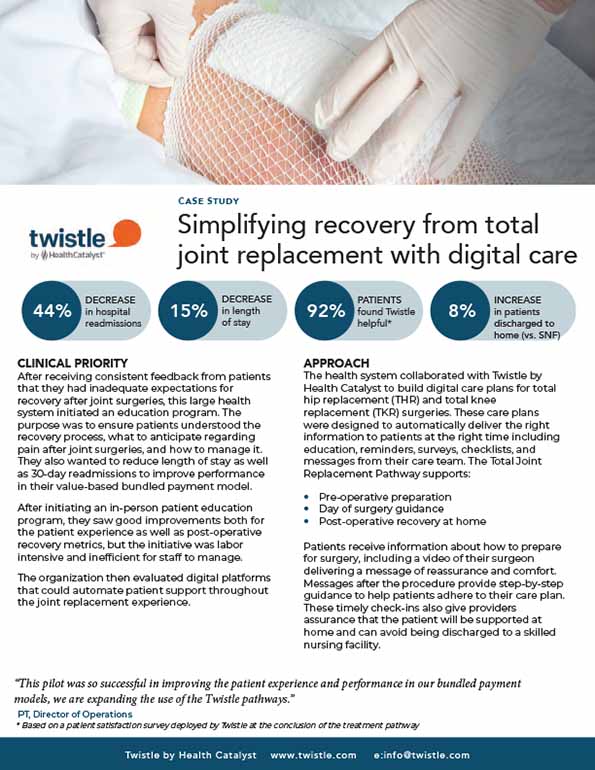After receiving consistent feedback from patients that they had inadequate expectations for recovery after joint surgeries, this large health system utilized a digital platform to automate patient support—ensuring patients understood the recovery process, what to anticipate regarding pain after joint surgeries, and how to manage it.
After receiving consistent feedback from patients that they had inadequate expectations for recovery after joint surgeries, this large health system initiated an education program. The purpose was to ensure patients understood the recovery process, what to anticipate regarding pain after joint surgeries, and how to manage it. They also wanted to reduce length of stay as well as 30-day readmissions to improve performance in their value-based bundled payment model.
After initiating an in-person patient education program, they saw good improvements both for the patient experience as well as post-operative recovery metrics, but the initiative was labor intensive and inefficient for staff to manage.
The organization then evaluated digital platforms that could automate patient support throughout the joint replacement experience.
The health system collaborated with Twistle by Health Catalyst to build digital care plans for total hip replacement (THR) and total knee replacement (TKR) surgeries. These care plans were designed to automatically deliver the right information to patients at the right time including education, reminders, surveys, checklists, and messages from their care team. The Total Joint Replacement Pathway supports:
Patients receive information about how to prepare for surgery, including a video of their surgeon delivering a message of reassurance and comfort. Messages after the procedure provide step-by-step guidance to help patients adhere to their care plan. These timely check-ins also give providers assurance that the patient will be supported at home and can avoid being discharged to a skilled nursing facility (SNF).
“Loved receiving these text messages. They answered a lot of the questions I had written down for the doctor.”
“I liked being able to get timely reminders, ask questions, and communicate about how healing is going.”
- Patients Enrolled in Twistle, Satisfaction Survey
A cohort of patients undergoing a THR or TKR were invited to use Twistle and 83 percent of those invited adopted the program. Approximately two-thirds of the patients received a TKR and one-third a THR. The study compared outcome and cost data for 388 patients who used Twistle, with 751 patients who did not use Twistle.
"This pilot was so successful in improving the patient experience and performance in our bundled payment models, we are expanding the use of the Twistle pathways.”
- PT, Director of Operations
* Based on analysis conducted in 2020 by the organization and 2020 data on patient engagement provided by Twistle.


* Based on a patient satisfaction survey deployed by Twistle at the conclusion of the treatment pathway


